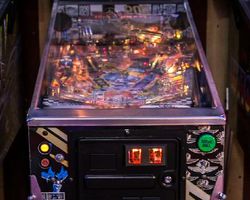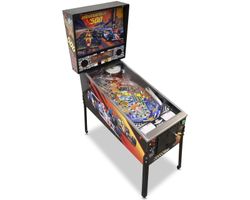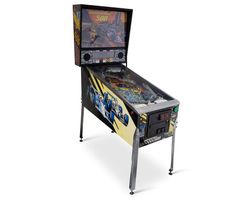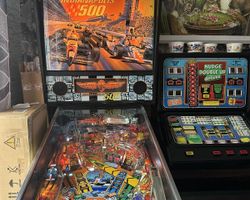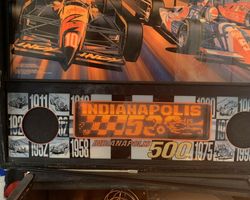Indianapolis 500
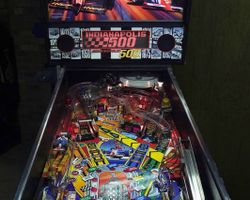
Average Prices: USD $1,000 to $3,200
Produced: June, 1995
Production Run: 2,249 units
Machine Type: Solid State Electronic
MPU: Williams WPC Security (WPC-S)
Players: 4
Design by: Dennis Nordman
Art by: Dan Hughes, Paul Barker
Dots/Animation by: Adam Rhine, Brian Morris
Mechanics by: Win Schilling, Armando Zuniga
Music by: Chris Granner
Sound by: Chris Granner
Software by: Mike Boon, Craig Sylla
The roar of engines, the blur of speed, and the distinct scent of burning rubber—these sensations are often confined to the racetrack, but in June of 1995, Bally Manufacturing Co. brought the thrill of the "Greatest Spectacle in Racing" to the pinball arena with Indianapolis 500. This machine, deeply rooted in the iconic auto racing event, stands as a testament to Bally’s engineering and design prowess during the mid-1990s.
History and Background
Indianapolis 500, often abbreviated as I500 or I5, emerged from the creative minds at Bally Manufacturing Co., part of the Williams Electronics Games family. Released on June 1, 1995, this solid-state electronic (SS) machine aimed to capture the essence of high-speed competition. The design team behind Indianapolis 500 was a collaborative effort, bringing together diverse talents. Dennis Nordman, a designer known for his imaginative playfields, took the lead on the game’s layout. Artwork was handled by Dan Hughes and Paul Barker, who translated the visceral energy of auto racing into vibrant visual compositions. Chris Granner composed the music and sound, crafting an auditory experience that mirrored the intensity of the track. The software, which dictated the game’s intricate rules and modes, was developed by Craig Sylla and Mike Boon. Mechanically, the game benefited from the ingenuity of Win Schilling and Armando Zuniga.
With a production run of 2,249 units, Indianapolis 500 entered the market as a WPC Security (WPC-S) generation game, indicating its place within Williams' advanced pinball system. An interesting anecdote surrounds the game’s visual development: the original backglass artwork by Dan Hughes was conceived before it was even decided whether the game would be a Williams or Bally release. Furthermore, the game’s cabinet and playfield art underwent significant revisions late in development. This was largely influenced by feedback from a German distributor, who felt early color schemes resembled "baby colors." This led to a wave of color alterations, resulting in variations seen on different production runs and even prototype machines. For instance, some cabinets feature a solid red color where others transition from orange to yellow, and tire colors on the race cars can vary from darker blue to royal purple. Mark Weyna, a key figure in the game's early stages, noted that production games often featured a third color version compared to protos and early samples, further contributing to the visual diversity of Indianapolis 500 machines found today. The game also boasts authentic voice call-outs from real racing commentators, including ABC-TV's Paul Page and Bobby Unser, alongside Tom Carnegie, the longtime "Voice of the Indy 500" and Indianapolis Motor Speedway's lead announcer, lending an unparalleled layer of authenticity to the racing experience.
Signature Features and Design
Indianapolis 500 differentiates itself with several distinctive features that directly immerse players in the racing theme. A central attraction is the spinning car model on the playfield. This isn’t merely a static toy; it integrates directly into gameplay. The car acts as an eccentric weight, causing the entire machine to shake intermittently, simulating the rumble and vibration of a high-performance race car. Its velocity increases dynamically when the right ramp is successfully shot, adding to the sensation of escalating speed.
Another pivotal mechanism is the "Turbo Lock." This feature skillfully captures and locks balls within one of its chambers before firing them back onto the playfield with remarkable speed. This rapid ball delivery system is designed to simulate a burst of acceleration, injecting a surge of pace into the game flow. Complementing this is the "Pit Stop" feature. When illuminated, this temporarily locks a ball within another car replica on the playfield, granting the player an opportunity to make another shot for a frenzied two-ball multiball. This brief, intense burst of multi-ball action mirrors the quick decisions and frantic pace of a real pit stop, where every second counts. The use of a digital game in the dot matrix display (DMD) for a video mode also sets it apart, offering a different form of engagement beyond traditional flipper action. The machine also incorporates an autoplunger for consistent starts and offers an operator-adjustable option for unlimited buy-in balls per player, providing extended gameplay for those seeking to conquer the track.
Playfield and Mechanics
The playfield of Indianapolis 500 is engineered for speed and precision, reflecting the rapid-fire nature of auto racing. The layout incorporates three flippers: two standard lower flippers and an additional upper flipper, which are crucial for navigating the various ramps and shot opportunities. Three pop bumpers located strategically on the playfield keep the ball active and unpredictable, echoing the unpredictable nature of a race.
The game features two main ramps, which are primary targets for building score and progressing through modes. The flow is designed to be fast and fluid, encouraging continuous ball movement and rewarding accurate, rapid shots. The playfield layout emphasizes a sense of control despite the high speed, allowing players to guide the ball with purpose. Shots are structured to create a loop, where successful ramp shots can feed back into the flippers, allowing for a continuous, high-scoring rhythm. The overall design philosophy leans into the theme, with objectives like completing laps and advancing positions integrated directly into the gameplay.
Visually, the playfield is adorned with artwork depicting racing elements—cars, track lines, pit crew members—all aimed at immersing the player in the Indianapolis 500 environment. However, opinions on the playfield artwork's aesthetic quality vary, with some finding it less polished than the cabinet art. The lighting scheme on the playfield is dynamic, illuminating targets and paths to guide the player and highlight progress, creating a visually engaging experience that reinforces the speed and intensity of the race. The light-up targets, while enhancing the aesthetic and providing clear shot indicators, were noted by some to be prone to failure, a minor maintenance consideration.
Gameplay Dynamics
Indianapolis 500's gameplay mechanics are centered on capturing the intensity and strategy of auto racing. The game offers a robust scoring system driven by completing various objectives, advancing through modes, and hitting key shots. Progression often involves completing laps and advancing positions, mirroring the challenges of a real race. A key highlight is the three-ball multiball, which activates when specific targets are lit and hit, unleashing a flurry of balls and escalating scoring opportunities.
Unique modes and challenges distinguish Indianapolis 500. The Pit Stop mode, as described, offers a strategic opportunity for a temporary two-ball multiball, demanding quick decisions and precise shots to maximize points. The Turbo Lock sequence is another standout; by repeatedly hitting the right ramp and locking balls in the Turbo Lock, players can trigger powerful scoring bonuses. The game also features a captivating video mode, where players use the flipper buttons to steer an Indy car left and right on the dot matrix display, dodging obstacles on the racetrack to earn an extra ball. This mode offers a distinct break from the main playfield action while maintaining the racing theme. Player strategies often involve mastering the various ramps and targets to build speed, unlock multiball modes, and complete laps efficiently. The integration of call-outs from real Indy commentators adds a layer of urgency and excitement to these gameplay moments, creating a highly immersive and memorable experience.
Reception and Legacy
Upon its release and in subsequent years, Indianapolis 500 garnered a largely positive reception within the pinball community. Its primary strengths are often cited as its fast, fluid, and challenging gameplay. Players frequently praise the effective use of upper and lower flippers, which contributes to excellent ball flow and a sense of control over the game. The integration of the Indianapolis 500 theme is consistently highlighted as a major success, with the real announcer call-outs and commentary elevating the experience and authentically weaving the racing concept into the gameplay objectives, such as completing laps and advancing positions. The sound design and music, created by Chris Granner, are also widely lauded for their ability to fit the action and create an immersive atmosphere. Key toys and features, including the Turbo Lock, the Pit Stop car, and the light-up targets, were well-received for enhancing the gameplay, with the unique spinning car being a particular point of interest. The cabinet artwork, depicting the vibrant energy of the race, is generally considered a highlight of the machine’s visual presentation.
However, Indianapolis 500 did receive some feedback regarding aspects that could be improved. For some players, the car racing theme, while expertly integrated, simply isn't their preferred subject matter, though this rarely detracted from the overall fun of the gameplay. A few players found that the Turbo feature, while innovative, could occasionally interrupt the rapid flow of the game rather than seamlessly integrating with it. Visually, while the cabinet art was praised, some opinions considered the playfield artwork to be subpar in comparison. Minor durability concerns were also noted regarding the light-up targets, which some owners found prone to failure.
Despite these minor points, the overall sentiment towards Indianapolis 500 remains overwhelmingly positive. Many pinball enthusiasts regard it as an underrated machine and a "keeper" for their collections. Its blend of high-speed action, strategic depth, and strong thematic integration appeals to both casual players and experienced collectors. Its legacy lies in its authoritative execution of a licensed sports theme, demonstrating how authentic voice talent and mechanical innovations could effectively translate a real-world spectacle into a captivating pinball experience. Indianapolis 500 stands as a vibrant example of Bally's mid-90s output, known for its engaging gameplay and successful thematic immersion.
Sponsored Links
 Ebay Listings
Ebay Listings
 Auction Results
Auction Results
| Cost | Location | Date |
|---|---|---|
| EUR €5,000 |  Belgium Belgium |
06 October, 2024 |
| USD $5,400 |  Florida, United States Florida, United States |
13 March, 2024 |
| USD $8,000 |  Ohio, United States Ohio, United States |
20 January, 2024 |
| USD $1,250 |  Ohio, United States Ohio, United States |
11 November, 2023 |
| GBP £2,727 |  Stoke-on-trent, United Kingdom Stoke-on-trent, United Kingdom |
05 October, 2023 |
| USD $4,900 |  Pennsylvania, United States Pennsylvania, United States |
22 July, 2023 |
| USD $7,200 |  Connecticut, United States Connecticut, United States |
07 July, 2023 |
| USD $6,500 |  Texas, United States Texas, United States |
22 September, 2022 |
| USD $5,500 |  Tennessee, United States Tennessee, United States |
13 September, 2022 |
| EUR €2,662 |  Hamburg, Germany Hamburg, Germany |
19 March, 2022 |


Private Policy · Search Website · Contact Us
As an eBay Partner, we may earn a commission from qualifying purchases made through links on this site, at no additional cost to you.
All trademarks and copyrighted materials remain property of their respective owners. All other content copyright 2007 - 2025 Pinpedia.

